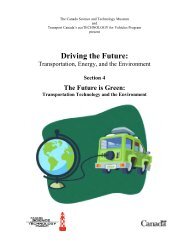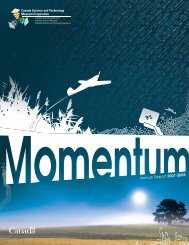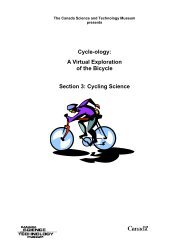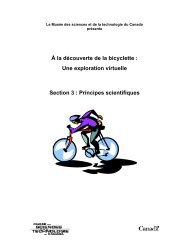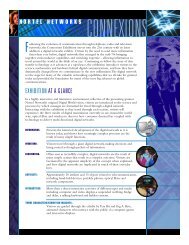Canada Science and Technology Museum
Canada Science and Technology Museum
Canada Science and Technology Museum
Create successful ePaper yourself
Turn your PDF publications into a flip-book with our unique Google optimized e-Paper software.
<strong>Canada</strong> <strong>Science</strong> <strong>and</strong> <strong>Technology</strong> <strong>Museum</strong><br />
Liquids <strong>and</strong> Solids<br />
K to Grade 3 • K to Cycle 1 (primary)<br />
Duration: 60 minutes<br />
Investigate the properties of materials through an<br />
exploration of liquids <strong>and</strong> solids. Probe the differences<br />
between the three states of matter, interactions between<br />
liquids of different densities, solids that dissolve in liquids,<br />
<strong>and</strong> buoyancy. Design a boat <strong>and</strong> see how much weight it<br />
can support. (ST5)<br />
Energy <strong>and</strong> Forces NEW!<br />
Grades 1 to 3 • K to Cycle 2 (primary)<br />
Duration: 60 minutes<br />
Explore the role that the Sun, air, <strong>and</strong> water play in energy<br />
production. Discover how these natural forces are harnessed<br />
<strong>and</strong> their impact on our everyday lives. H<strong>and</strong>s-on activities<br />
reinforce the underst<strong>and</strong>ing that everything that happens<br />
is the result of some form of energy. (ST8)<br />
7<br />
<strong>Science</strong> Seesaw <strong>and</strong><br />
Simple Machines<br />
Grades 1 to 3 • Cycle 2 (primary)<br />
Duration: 60 minutes<br />
Explore the principles of force <strong>and</strong> movement with<br />
this introduction to simple machines <strong>and</strong> the effects of<br />
friction. Explore the terms work <strong>and</strong> load as you look<br />
at the basic principles of levers <strong>and</strong> inclined planes.<br />
Investigate a multitude of mechanical devices that have<br />
changed the way we live. (ST7)<br />
Structures <strong>and</strong> Shapes<br />
Grades 1 to 3 • Cycle 2 (primary)<br />
Duration: 60 minutes<br />
Experiment to discover the characteristics of different<br />
structures <strong>and</strong> how they are designed to meet specific<br />
needs. Try building a tower or bridging a river to<br />
learn which geometric shapes are the strongest. This<br />
workshop encourages students to use their problemsolving<br />
skills while exploring mechanical devices <strong>and</strong><br />
building structures. (ST9)<br />
Grades 4 to 8 •<br />
Cycle 2 (primary)<br />
to Cycle 1 (secondary)<br />
Probing the Skies<br />
Grades 4 to 6 • Cycle 2 (primary) to Cycle 1 (secondary)<br />
Duration: 75 minutes<br />
Explore the components of our Solar System—touch real<br />
meteorites <strong>and</strong> compare the relative size of planets <strong>and</strong><br />
asteroids. See the motions of the planets, Sun, Moon, <strong>and</strong><br />
constellations in the <strong>Museum</strong>’s inflatable planetarium,<br />
<strong>and</strong> discover their effects on cycles of day, night, seasons,<br />
<strong>and</strong> eclipses. See the tools of astronomy exploration in<br />
the Helen Sawyer Hogg Observatory. (ST10)<br />
Introduction to Electricity<br />
Grades 4 to 6 • Cycle 3 (primary) to Cycle 1 (secondary)<br />
Duration: 75 minutes<br />
What are current <strong>and</strong> static electricity Discover which<br />
materials are good conductors, <strong>and</strong> which are good<br />
insulators. Learn the role of simple circuit components<br />
<strong>and</strong> draw circuit diagrams. Use circuit boards to see how<br />
series <strong>and</strong> parallel circuits work, <strong>and</strong> how each is used.<br />
Measure the amount of electricity various light bulbs<br />
consume, <strong>and</strong> use devices that produce electricity. (ST13)<br />
Looking at Light<br />
Grades 4 to 6 • Cycle 3 (primary)<br />
Duration: 75 minutes<br />
Discover how light is produced <strong>and</strong> transmitted as you<br />
move through activity stations. Experiment with different<br />
materials to study reflection, refraction, <strong>and</strong> absorption.<br />
View the world through instruments such as microscopes,<br />
telescopes, periscopes, <strong>and</strong> kaleidoscopes, <strong>and</strong> use<br />
special filters to explore the world of colour. (ST12)<br />
sciencetech.technomuses.ca




